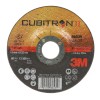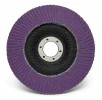What is the best abrasive disc to clean welds? Its characteristics
What is the best abrasive disc to clean welds? And how should it be used to achieve a perfect finish? Those working in the field of welding are especially concerned about carrying out the actual welding.
Here, the attention is set on the type of machine which is to be used to carry out the operation, the techniques to be put into practice, the preparation of the material, and so on.
However, the cleaning and finishing phase should not be neglected either: an unclean weld has bumps and imperfections which, aside from being flawed can, in some cases, compromise the functionality of the manufactured product.
Consider, for instance, what a bump caused by filler material which is not perfectly flush with the surface could mean inside a sliding mechanism. Here, then, it is necessary not only to identify which the best abrasive disk to clean the weld is, but also to learn how to use it the right way.
So, let’s have a look at how to clean a weld perfectly, on a case-by-case basis, as well as step by step.
How to clean welds
Beginners need to understand how to clean a weld the best way possible. Partly because the finishing of a welded piece is fundamental, and partly because beginners tend to create welds that, of course, are not exactly perfect, but rather coarse, containing debris, making cleaning necessary step.
But how should cleaning be carried out? Well, immediately after welding, while the material is still hot, it is possible to start cleaning the seam with a hammer, removing the most superficial layer without losing or compromising the underlying part.
Another useful tool can also be a brush with steel bristles, which is perfect for rubbing the welded part to remove any debris and metal droplets.
But a welder must not only keep a hammer and brush close and at the ready: another indispensable tool to achieve the desired finish is the angle grinder.
Using the correct abrasive disc, it is, in fact, possible to perfect the welding performed at very high levels: let’s have a look at how to clean welds with the angle grinder and how to choose the most suitable abrasive discs.
Cleaning welds with an angle grinder: a guide
Soon, we will outline how to choose the best abrasive disk to clean a weld: for now, let’s focus on the use of the angle grinder itself. So, imagine that you have just carried out a wire or electrode weld, and want to finish the joints you created.
The welded parts should be fastened to the bench, so that they can comfortably be worked on with the angle grinder with both your hands: this way, the operation will be safer, more effective, and easier to control, leading to a better result.
Once all the necessary personal protective equipment is in place – such as gloves and glasses – it is possible to actually start removing excess material with the abrasive disc, making sure to remove only the top of the seam, and not the material that constitutes the welded surface itself, be it sheet or a tubular form.
The correct use of an angle grinder involves positioning it perpendicularly to the seam, ensuring as much control as possible, which would be difficult to achieve in a parallel position.
What is the best abrasive disc to clean welds?
To understand which the best abrasive disc to clean welds is, it is best to start from a premise: a welder who wants to achieve optimal results should always work with two separate abrasive discs, and, even better, with two angle grinders.
The first should mount an abrasive disc to meant to rough – the rough abrasive disc – and the second should, instead, mount a lamellar disc.
Some beginners opt only for the lamellar disc, which is, however, designed only for the final finishes: in case of material accumulation, the slats that make up this disc can become damaged very quickly.
Much better, then, to smooth the seam with a normal abrasive disc and only then use a lamellar disc, to standardize and perfect the obtained surface.
Cleaning a weld of a fitting is a different story. In this case, it is best to use a hard fibre disc delicately compacted, to avoid burrs, and to then sand the surface by hand with a special sanding tape.







